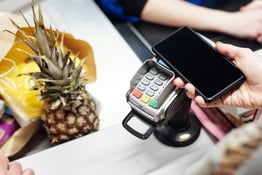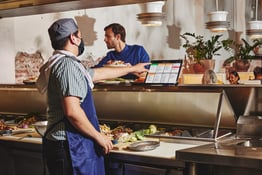Merging the concepts of a food hall and a ghost kitchen, Dallas restaurateur Markus Pineyro is expanding on the idea of a virtual restaurant with the creation of Krave, set to open this June. The idea is to allow customers to order multiple cuisines through one spot, enabled by licensing existing restaurant and retail brands. They’ll all operate in tandem out of a 1,400-square-foot kitchen, along with a few new brands created just for Krave.
“One of our main goals is to create optionality and be able to appease multiple cravings in one order,” says Pineyro. “So the idea is if someone wants a sandwich and taco and a pint of ice cream, plus a pressed juice, they can come to our platform and order all of it.”
Customers will place orders through Krave’s native platform or a third party app, with options for delivery or pickup. The pickup process will be entirely digital, using a QR code that customers will scan to retrieve orders from temperature-controlled lockers.
“It’s a frictionless experience for the user,” says Pineyro. “There’s no getting out your card, talking to the cashier, waiting in line – it’s completely seamless, which is what we really wanted to create.”
We sat down with Pineyro to learn more about the inspiration behind Krave and where he sees the future of fast-casual.
I’d love to hear more about your background and what led up to you creating Krave.
I've been in the industry for 17 years now, 15 of those as an operator. I started my first restaurant when I was 24 in 2007, and over the years, I always had four to six restaurants at a time. Things kind of slowed down the last four or five years, and I was just not happy with the traditional P&L and the margins of the restaurant space.
This industry is what I'm passionate about, so I started thinking about how I could revolutionize the P&L. As COVID was hitting, I was learning more about technology and ghost kitchens, and then this came to fruition.
We actually built a whole Cloud-Kitchen-type model. But the more we dug into it, the more we realized there were some holes in the business model. So we said let’s pivot and create this other model that’s much more nimble, much less capital intensive, and a little bit less risk[y]. So that's how it came about, and my partner and I have been working on it for almost two years.
We are a vertically integrated food delivery marketplace, so we control the ordering platform, the food production, and we have certain control of the delivery. What we’re doing different from the traditional food hall or a concept like CloudKitchen is we aren’t leasing space to outside concepts. We’re licensing existing concepts for a fee and selling their food through our platform.
Do you think restaurants have become more open to partnering and licensing their brand for a concept like this since the pandemic?
I think they’re becoming more understanding that it’s a new frontier in the restaurant space and are very excited to test the waters. And they’re happy to have a partner like us – we’re selling for them, so they’re not responsible for sales and staff, and there’s much less risk in the risk-reward proposition.
As an example, one of our partners is from Austin, and they’re not in the Dallas market, so it’s an opportunity to open in a new market without having to wait over a year for construction or raise a significant amount of capital to open a brick-and-mortar.
How many brands are you currently partnered with?
We have three partners in terms of licensing, and we’re developing three of our own brands. We also have six cloud retail partners. The cloud retail component is like a last mile marketplace for consumer packaged goods, meaning we could sell you a pint of ice cream, cookies, pressed juices, dumplings.
How’d you choose the lineup of food brands to partner with?
We want to appease multiple cravings in one order, with one ticket, and one ordering free, and have it all arrive at the same time, at the same temperature.
We hired an outside analytics company to tell us, based on our market location, what are the best-selling items in the delivery space at this time. Based on those items, we went out and curated our list of concepts.
Do you see yourself changing your offerings based on market changes?
Absolutely. That’s part of our model. We want to work with local chefs and do pop-ups. We want to work with regional and national brands, and do limited time offers. And if there’s a concept that’s trending in New York City, for example, and there’s none of those [type of concepts] here in Dallas, we can create a brand and bring that trend instantaneously without having to wait to open a brick-and-mortar.
It’s an extremely liquid transaction. Once we’re open, I can sign a deal with a licensed brand today and be live in four weeks.
For pick-up, you’ve minimized human interaction with a locker system. Do you see that as the future of fast casual?
Absolutely. There’s two ends of the spectrum for hospitality. There are the restaurants where people go out and have a steak and drink some wine, and then there’s other side of the spectrum where we fall, where you want to provide extreme convenience, and that’s going to rely on technology and efficiency. Any smart restaurant operator should be looking at this space.
Tell me about your choice to create a native ordering platform for food delivery.
Part of the progression of where the consumer is going is that they’re migrating towards first party. Third party will remain, but with first party, you eliminate fees, you control the quality better, and you create a better experience for your customer. When Uber or DoorDash sell your food, they’re not accountable for the food quality or the temperature and consistency. We want to be responsible for the entire experience.
Do you see this concept as one that could replace the traditional food hall model?
The traditional food hall falls into experience dining, so I don’t see those as our competition. Our main thing is providing that delivery takeout experience for the customer. This is just a bit of a spin on the delivery takeout marketplace.
Do you plan to expand your operations to other cities?
Our model is built for scale. It’s extremely easy for us to build out another kitchen. We can do it for a fraction of the cost of opening a traditional restaurant. And we can slide into any retail environment because we don’t have to be zoned as a restaurant.
We want to grow in Dallas, and then at the same time, go into additional markets like Austin and Houston. We definitely want to focus on Texas first, but we see our growth outside of Texas as well.
What are you most excited for as you grow?
It’s really the marriage of hospitality and technology and what it will allow us to do in the future, whether it’s drone delivery, robot delivery, or robotics in the kitchen. All of that we see as part of our growth plan.
Grace Dickinson is a reporter at Back of House. Send tips or inquiries to grace@backofhouse.io.





